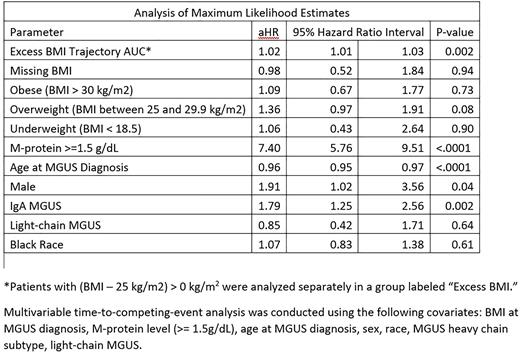Abstract
Background: Obesity is a known risk factor for multiple myeloma (MM), as prior studies have shown that body mass index (BMI) greater than 25 kg/m2 (at a fixed time point) increases the risk for MM and its premalignant condition, monoclonal gammopathy of undetermined significance (MGUS). However, to date, no studies have evaluated whether changes in BMI over time affect the progression of MGUS to MM. We aimed to assess the association between changes in BMI following a diagnosis of MGUS and the progression of MGUS.
Methods: Patients with MGUS from 1999-2021 in the Veterans Health Administration were identified. We used a natural language processing (NLP) based algorithm to confirm MGUS diagnosis and progression, including smoldering MM and MM. Only patients with IgG, IgA, or light chain MGUS and black and white patients were included in the analyses. Patients with Diabetes Mellitus (DM) were excluded from analysis due to potential confounding bias. Patients who progressed within 5 years of MGUS diagnosis were also excluded. Excess BMI was defined as BMI over 25 kg/m2. To capture the trajectory of excess BMI, the area under the curve (AUC) of excess BMI during the 5 years following MGUS diagnosis was calculated. A multivariable time-to-competing-event analysis was performed to estimate the multivariable-adjusted association of AUC of excess BMI with progression with death as the competing event. The covariates included BMI at MGUS diagnosis, M-protein level (>= 1.5g/dL), age at MGUS diagnosis, sex, race, MGUS heavy chain subtype, light-chain MGUS.
Results: After applying our inclusion and exclusion criteria, our analytic cohort included 7,739 MGUS patients. Our multivariable time-to-competing-event analysis revealed a positive association between excess BMI trajectory and MM progression (multivariable-adjusted hazard ratio, aHR, 1.02, 95% confidence interval, CI, 1.01-1.03) - a 2% increase in risk of progression per 1 kg/m2 increase in excess BMI per year following MGUS diagnosis.
Conclusion: In patients diagnosed with MGUS, increases in excess BMI by 1 kg/m2 per year were associated with 2% increased risk of progression to MM. This finding suggests that maintaining a healthy weight in patients with MGUS may reduce the risk of progression.
Disclosures
Sanfilippo:ACS-IRG: Research Funding; Covington & Burling LLP: Other: Expert Case Review; Health Services Advisory Group: Consultancy; K01 NHLBI: Research Funding; NHLBI NIH: Other: Loan Repayment program; Quinn Johnston: Other: Expert Case Review.
Author notes
Asterisk with author names denotes non-ASH members.


This feature is available to Subscribers Only
Sign In or Create an Account Close Modal